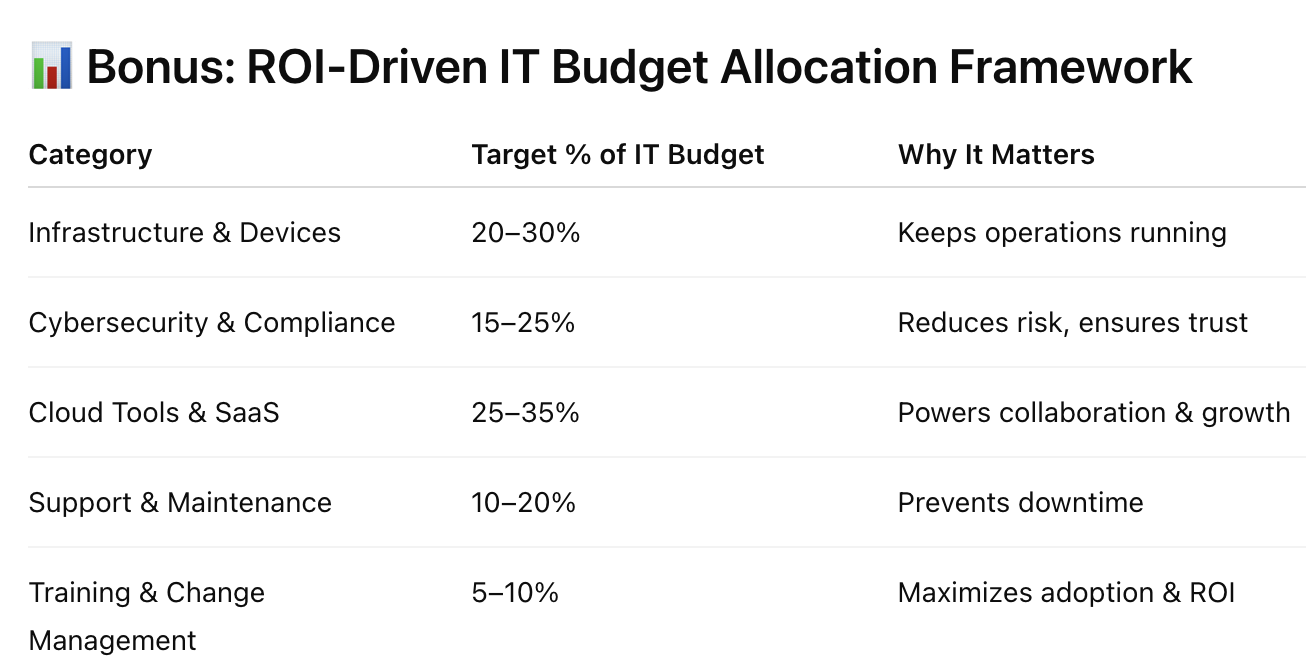Maximizing ROI on IT Spend: 5 Budget-Smart Moves for Growing Business
IT spending isn’t just about keeping the lights on.
For growing businesses, it’s a strategic lever—when spent wisely, IT can drive revenue, protect assets, and unlock productivity.
Yet many SMEs and mid-sized companies pour thousands into tools, vendors, or infrastructure without a clear view of value versus cost.
This guide breaks down five smart, ROI-focused IT budgeting strategies that help growth-stage businesses spend less, get more, and scale with confidence.
Why ROI-Focused IT Spending Matters
If you’re growing—from 10 to 50+ staff—your IT complexity grows too. That means your IT budget can’t just be a cost center. It needs to:
Reduce operational friction
Improve data security and compliance
Enable scale without constant rework
Deliver measurable returns on every dollar spent
So how do you ensure every line item in your IT budget contributes to those outcomes?
Let’s dive into 5 proven strategies.
1. Consolidate & Standardize Your Tech Stack
The Problem: As teams grow, so does tech sprawl—multiple chat apps, random file storage tools, overlapping subscriptions. This leads to inefficiencies, higher support costs, and security blind spots.
The Fix: Audit your software ecosystem and eliminate redundancy.
Smart Moves:
Standardize on Microsoft 365 or Google Workspace for productivity
Pick a single project management tool (e.g., Asana, ClickUp, or Monday)
Use one cloud storage platform company-wide
Consolidate communication into one channel (e.g., Teams or Slack)
🎯 ROI Booster:
Less training, lower licensing costs, and streamlined IT support can save 20–40% in software costs annually.
2. Invest in Scalable, Cloud-First Infrastructure
The Problem: On-premise servers and hardware-heavy setups are expensive to scale and maintain.
The Fix: Shift toward cloud-based tools and platforms that grow with your business.
Budget-Smart Examples:
Use cloud file storage (OneDrive, Dropbox Business) instead of physical file servers
Replace legacy email servers with Google Workspace or Microsoft Exchange Online
Host apps in the cloud (AWS, Azure, GCP) with autoscaling capabilities
💡 Case Insight: A 30-user SME cut IT overhead by 35% by moving from an on-site server to a cloud-based file system and VoIP platform.
🎯 ROI Booster: Avoid upfront capital costs, reduce downtime, and only pay for what you use.
3. Don’t Skimp on Cybersecurity — Spend Smart
The Problem: Many SMEs delay investing in cybersecurity until after a breach, when costs skyrocket.
The Fix: Implement foundational cybersecurity controls early, using bundled or grant-supported solutions.
High-Impact, Low-Cost Actions:
Enable multi-factor authentication (MFA) for all apps
Deploy endpoint detection & response (EDR) (e.g., Bitdefender, CrowdStrike)
Use email filtering & anti-phishing tools
Train staff with phishing simulations
Backup critical data (use both local and cloud)
🛡️ Grants like the PSG and Cybersecurity Certification Grant can cover up to 80% of implementation costs in Singapore.
🎯 ROI Booster: Reduce breach risk by up to 90%, prevent regulatory fines, and protect brand trust—critical intangible ROI.
4. Outsource Smart — Especially IT Support
The Problem: Hiring full-time IT staff for a 20–50 employee business is often too costly—but doing nothing risks downtime and security issues.
The Fix: Partner with a Managed IT Service Provider (MSP) for 24/7 support, monitoring, and maintenance at a fraction of the cost of in-house staff.
What to Look For:
Flat monthly fee (predictable budgeting)
SLA-backed response times
Proactive monitoring and patching
Security advisory included
💰 Example: An SME with 35 users pays $3,000/month for MSP support, versus ~$8,000/month for a full in-house IT team (including CPF, tools, and training).
🎯 ROI Booster: Lower costs, faster issue resolution, and less downtime = higher productivity per employee.
5. Tie IT Projects to Business Goals (Not Just Tech Trends)
The Problem: Many businesses spend reactively on IT—replacing what breaks, buying what’s trendy, or adding tools without a clear business case.
The Fix: Prioritize IT initiatives that directly support:
Revenue growth (e.g., CRM integrations, website upgrades)
Customer experience (e.g., faster portals, real-time chat)
Efficiency (e.g., automation, faster onboarding)
Compliance and risk reduction
Use These Questions to Evaluate IT Spend:
Will it reduce time-to-value for our clients?
Does it eliminate manual or duplicated work?
Will it reduce our risk exposure?
Can it be measured in productivity or cost savings?
📘 Example: An SME automated its invoice approvals with cloud-based tools, saving 10 hours/week across 3 departments = $20,000+ saved/year.
🎯 ROI Booster: IT investments tied to business KPIs are 4x more likely to deliver measurable returns (Gartner, 2024).
Final Takeaways: Spend Less, Grow More with Strategic IT
IT is no longer a background expense—it’s a force multiplier for business success. Here’s how to maximize ROI:
Consolidate to reduce waste
Go cloud-first to stay agile
Invest early in security to avoid costly mistakes
Outsource what doesn’t need to be in-house
Align every dollar with a measurable business goal
Your IT budget isn’t just a cost—it’s your engine for smarter growth.
Need Help Maximizing Your IT ROI?
We help SMEs and mid-sized businesses in Singapore:
Audit their current IT spend
Eliminate waste and risk
Build ROI-driven technology plans



